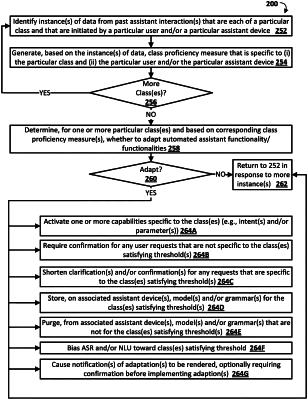| CPC G10L 15/22 (2013.01) [G06F 16/90332 (2019.01); G06F 16/9035 (2019.01); G06F 21/121 (2013.01); G10L 15/26 (2013.01); G06F 3/04812 (2013.01)] | 15 Claims |

|
1. A method implemented by one or more processors, the method comprising:
generating a class proficiency measure that is specific to a class of interactions with an automated assistant and that is specific to a particular user, wherein generating the class proficiency measure comprises:
processing instances of data for past assistant interactions, based on the past assistant interactions being of the class and being initiated by the particular user; determining that the class proficiency measure satisfies a threshold; in response to determining that the class proficiency measure satisfies the threshold:
activating, for the particular user, one or more capabilities specific to the class, wherein the one or more capabilities are, prior to the activating, dormant for the particular user and the particular assistant device, wherein the one or more capabilities specific to the class comprise one or both of:
a particular intent for the class of interactions,
and a particular parameter for an already activated intent for the class of interactions;
in response to determining that the class proficiency measure fails to satisfy the threshold:
maintaining the one or more capabilities as dormant for the particular user.
|